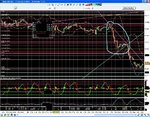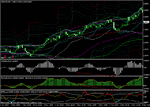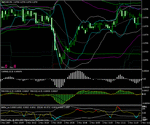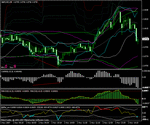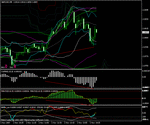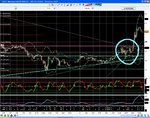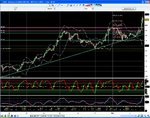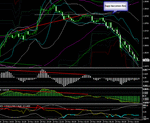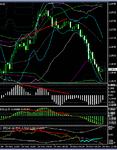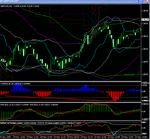bbmac
Veteren member
- Messages
- 3,584
- Likes
- 789
Identifying the highest probability technical entry points to a trend after a pullback.
Underlying assumptions:
1. Markets trend, some better than others. There is much empirical evidence to support this assumption.
2. Respective Buyers and Sellers view pullbacks in a trending instrument as' better value' buying opportunities in an uptrend / selling opportunities in a downtrend.
NB: The discussion below assumes an uptrend example
Before examining the central question of where the optimum entry/re-entry point is following a pullback, let us first examine what a pullback is and any technical phenomenons that exist therein.
A pullback in a trend is created by sellers overwhelming buyers at a level at which they a. think fair value has been reached and therefore take profit or b. the asset is over-valued and therefore sell. Of course if sufficient number of market participants believe price to be overvalued, the pullback could be deeper or even be the start of a new downtrend, howsoever long.
In technical terms, the tools at our disposals to determine whether either of these are the case are;
1. An assessment of the relative strength of the prevailing resistance that caused the retrace
2. Oscillator divergence/extreme readings on the longer time frames.
3. Price's relationship to it's historical volatility as measured for example against it's ATR.
Generally speaking price does re-test or attempt to re-test the area of the most recent highest highs if only to make an equal or lower high, lest the sellers resume their action re point b. above. The keytechnical factors in determining where the optimum place is to enter / re-enter a trend, ie: how far prices will pullback/retrace before the buyers assume that better value exists and re-enter the market in the direction of the prevailing trend are
a. The technical phenomenon of Support becomes Resistance (SBR) and Resistance becomes Support (RBS)
1. Where is the last identifibale broken resistance -and-
2. Are there are significant points in what we understand to be the last RBS zone, ie: the last now exceeded higher swing high and the higher swing low (the higher swing low being the other part of the price action phenomenon that occurs in a trend.) These points may include
a. Fib retraces
b. former offers
c. Any previous obvious higher swing highs further back on the chart in the same trend that fall in the last RBS zone.
From this we can guauge where the most confluence exists that suggests that sufficient market participants/volme will act and enter / re-enter athe trend accordingly.
Personally I look for certain repeatable hidden/reverse divergence / band deviation set-ups (discussed elsewhere on this site) within the framework outlined in the attached document (which is posted elsewhere on this forum.) I note too that others on this site advocate confluence as the key ingredient in finding high probability supp/res based areas, using price action to confirm, and I refer most recently to the thread by trader_dante
Underlying assumptions:
1. Markets trend, some better than others. There is much empirical evidence to support this assumption.
2. Respective Buyers and Sellers view pullbacks in a trending instrument as' better value' buying opportunities in an uptrend / selling opportunities in a downtrend.
NB: The discussion below assumes an uptrend example
Before examining the central question of where the optimum entry/re-entry point is following a pullback, let us first examine what a pullback is and any technical phenomenons that exist therein.
A pullback in a trend is created by sellers overwhelming buyers at a level at which they a. think fair value has been reached and therefore take profit or b. the asset is over-valued and therefore sell. Of course if sufficient number of market participants believe price to be overvalued, the pullback could be deeper or even be the start of a new downtrend, howsoever long.
In technical terms, the tools at our disposals to determine whether either of these are the case are;
1. An assessment of the relative strength of the prevailing resistance that caused the retrace
2. Oscillator divergence/extreme readings on the longer time frames.
3. Price's relationship to it's historical volatility as measured for example against it's ATR.
Generally speaking price does re-test or attempt to re-test the area of the most recent highest highs if only to make an equal or lower high, lest the sellers resume their action re point b. above. The keytechnical factors in determining where the optimum place is to enter / re-enter a trend, ie: how far prices will pullback/retrace before the buyers assume that better value exists and re-enter the market in the direction of the prevailing trend are
a. The technical phenomenon of Support becomes Resistance (SBR) and Resistance becomes Support (RBS)
1. Where is the last identifibale broken resistance -and-
2. Are there are significant points in what we understand to be the last RBS zone, ie: the last now exceeded higher swing high and the higher swing low (the higher swing low being the other part of the price action phenomenon that occurs in a trend.) These points may include
a. Fib retraces
b. former offers
c. Any previous obvious higher swing highs further back on the chart in the same trend that fall in the last RBS zone.
From this we can guauge where the most confluence exists that suggests that sufficient market participants/volme will act and enter / re-enter athe trend accordingly.
Personally I look for certain repeatable hidden/reverse divergence / band deviation set-ups (discussed elsewhere on this site) within the framework outlined in the attached document (which is posted elsewhere on this forum.) I note too that others on this site advocate confluence as the key ingredient in finding high probability supp/res based areas, using price action to confirm, and I refer most recently to the thread by trader_dante
Attachments
Last edited:

